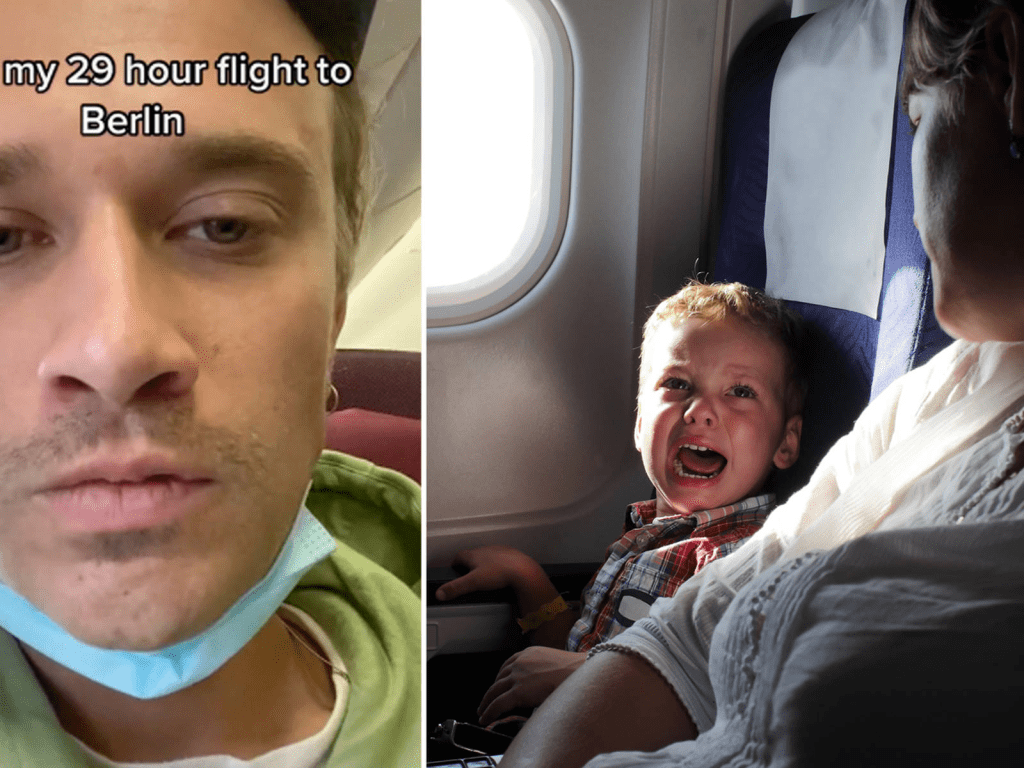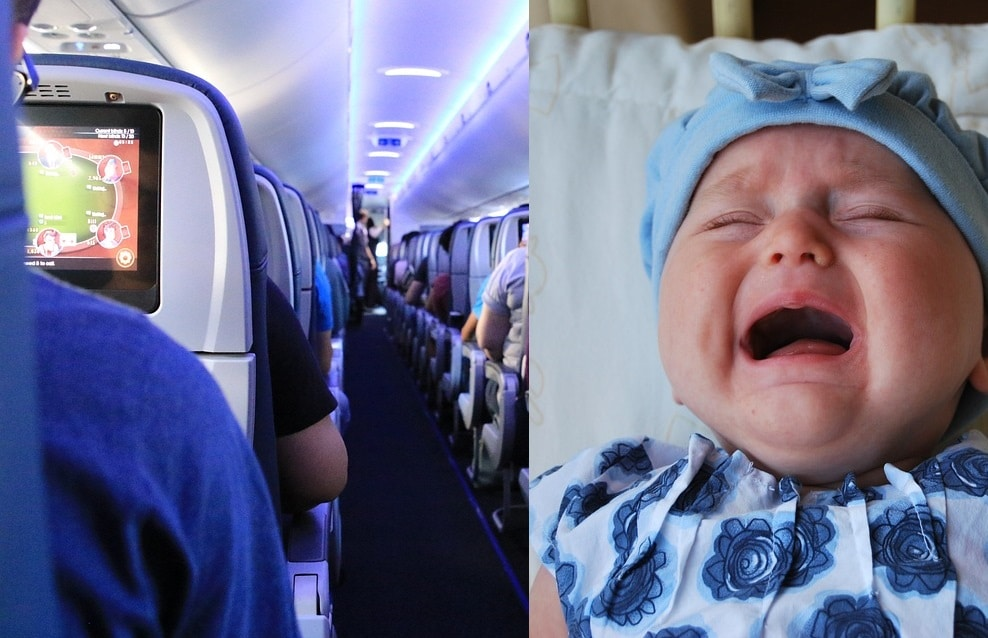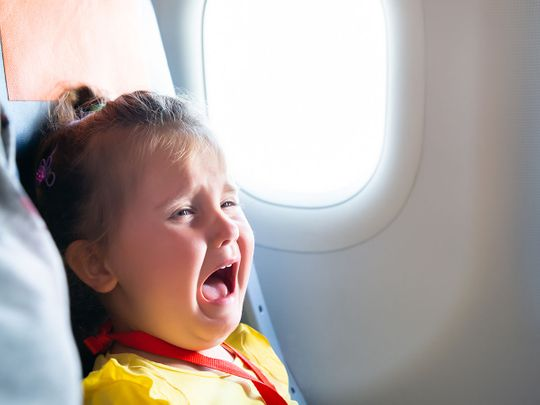A recent viral TikTok video has sparked a heated debate over the challenges of flying with young children, particularly after a passenger documented his 29-hour ordeal with a screaming baby on a long-haul flight to Germany. The video, shared by Henry Beasley—a New Zealand musician—has fueled calls for child-free flights, with many passengers voicing their frustration and offering their own suggestions for improving the flying experience. But is the solution really child-free zones, or is there a better way to accommodate families and other passengers?
The 29-Hour Flight From Hell: A Passenger’s Experience

Henry Beasley, known for being part of the New Zealand duo Balu Brigada, took to TikTok to share his hilarious yet exasperating experience during a 29-hour journey to Berlin. In his video, he humorously invites viewers to “rate my 29-hour journey to Berlin” before showcasing his reactions to the constant cries of a baby sitting nearby.
The video is a mix of frustration and humor, with Henry capturing his eye twitches, exaggerated sighs, and attempts to maintain composure. Despite the grueling situation, he jokes about the child’s “incredible stamina” and rates their “stellar performance” a “10/10,” bringing a lighthearted touch to an otherwise stressful moment. This relatable scenario quickly resonated with viewers, earning over 3.7 million views and sparking widespread discussions about flying with babies.
A Shared Struggle: The Frustrations of Flying with Children
Henry’s video wasn’t just about his personal experience; it struck a chord with many who have endured similar challenges. The comments section of the TikTok post was filled with mixed reactions, with some viewers sympathizing with the exhausted passenger, while others questioned why parents would choose to bring babies on such long flights.
One commenter pointed out, “Kids don’t even remember anything from those trips. Why would anyone do that?” This reflects a common sentiment that flying with young children is not only difficult for the parents but also for fellow passengers who are forced to endure the discomfort.
Even parents themselves weighed in, admitting the hardship of traveling with small children. “I know some people don’t have the option, but I never took my babies or toddlers on flights. Ever. It’s painful for everyone,” one parent shared. This perspective suggests that while traveling with young children might be a necessity for some, it often leads to a stressful and uncomfortable experience for everyone on board.
Controversial Solutions: Should Airlines Offer Child-Free Flights?
As the debate surrounding Henry’s viral video continued to grow, the idea of child-free flights gained significant traction. Many viewers, particularly those who sympathized with Henry’s plight, expressed a willingness to pay extra for flights that banned children. The desire for a quieter, more peaceful flying experience seems to be an appealing option for travelers who are frustrated by noisy, disruptive children on long flights.
Some airlines have already begun to experiment with child-free sections. For example, Scoot, a budget airline, has introduced a “ScootinSilence” section, which prohibits children under 12 from sitting in that area. Japan Airlines also allows passengers to see where babies will be seated on the flight’s seat map, enabling travelers to plan their seating accordingly.
These options, while not widespread, do offer a potential solution for passengers who prefer a quieter, more relaxed flight. However, the concept of child-free zones or flights has sparked criticism from some quarters. Opponents argue that such measures could be unfair, as flying with children is a natural part of life, and it would be unreasonable to restrict families from certain areas of the plane.
The Practicality and Fairness of Child-Free Zones
While child-free sections sound like an attractive solution for some, critics question the practicality and fairness of such measures. For one, children are not the only source of in-flight disturbances. Noise, uncomfortable seating, and poor service can make any flight a challenge, regardless of whether children are on board. The idea of segregating families from other passengers could lead to feelings of discrimination or exclusion.

Moreover, families with young children often do not have many options when it comes to traveling long distances. Some argue that child-free flights could become an elitist service, leaving families with limited choices and making air travel even more difficult for those who already face challenges. As one commenter suggested, “We can’t always choose when or where we travel. Sometimes, it’s just a part of life.”
Finding a Middle Ground: Compromise Solutions for Families and Other Passengers
So, is there a middle ground? Instead of fully banning children from flights or creating child-free zones, could airlines come up with other strategies that make flying more bearable for both parents and fellow passengers?
One potential solution could be the introduction of family-friendly flights that cater specifically to those traveling with children. These flights could offer child-centric amenities, such as extra space for strollers, child care services, or even designated play areas on board. This way, families could travel comfortably while minimizing disruptions to other passengers.
Another option could be better communication between airlines and passengers, allowing those with specific preferences—such as avoiding families with young children—to book seats in certain sections of the plane. This would allow for more flexibility while ensuring that families are still accommodated on the flight.

Additionally, airlines could offer incentives or discounts to passengers who are willing to travel during off-peak hours when flights tend to be quieter, offering a win-win for both families and those seeking a more peaceful journey.
The Growing Call for a Child-Free Flight Option
Despite the controversy, there is a growing demand for child-free flight options. As air travel continues to become more accessible, the challenges of flying with children are likely to become a bigger issue for both passengers and airlines. Whether airlines will adopt child-free zones or offer more family-focused services remains to be seen, but one thing is clear: the desire for a quieter, more relaxed flight experience is not going away anytime soon.
Conclusion: Navigating the Future of Air Travel with Children
The viral video of Henry Beasley’s 29-hour journey highlights a shared struggle many passengers face when flying with young children. While some people advocate for child-free flights as a solution, others question the fairness and practicality of such measures. As the debate continues, it’s clear that both families and non-families need to find a way to compromise, ensuring that air travel remains comfortable and accessible for everyone.
Whether through designated family zones, better communication, or more flexible flight options, the key to solving this issue lies in understanding the challenges faced by all passengers. By finding common ground, we can make air travel a better experience for everyone, regardless of their age.


